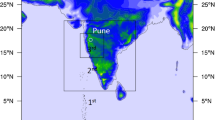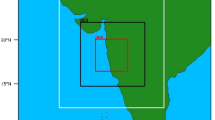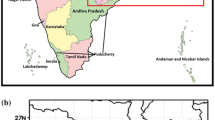Abstract
Prediction of thunderstorms with accurate space–time-intensity is still a challenging task in the tropical region. This paper examines the development of a pre-monsoon thunderstorm over a coastal urban city with an advanced 205 MHz VHF radar, and simulates the moist thermodynamical processes with the help of Weather Research and Forecasting model. The state-of-the-art VHF radar has been utilized to explore the dynamical features of the storm that occurred over Cochin, India on a typical pre-monsoon day. The thermodynamical processes have been simulated with different sets of microphysics-, cumulus-, and boundary layer- parameterization schemes. The performance of each combination of various parameterization schemes is examined in terms of correlation and standard deviation with the observations. Out of the 42 various combinations, it is found that the combination of Thompson microphysics-, Grell Freitas Ensemble cumulus-, and Meller Yamada Janjic planetary boundary layer- schemes is able to reproduce the moist thermodynamics better when compared with ground observations involving automatic weather station (AWS) and the VHF radar. The WRF model simulates the preconditioning of the atmosphere, mid-level blocking and release of convective instability, and moisture convergence in a reasonable manner. The identified physics suite is able to predict the storm development realistically and the study offers a reliable prospect of real-time prediction of thunderstorms over this region with the WRF model.













Similar content being viewed by others
Data availability
Data can be made available upon reasonable request to the corresponding author.
References
Ananthakrishnan R (1977) Some aspects of the monsoon circulation and monsoon rainfall. Pure Appl Geophys 115:1209–1249
Basu GC, Mondal DK (2002) A forecasting aspect of thundersquall over Calcutta and its parameterization during pre-monsoon season. Mausam 53(3):271–280
Bernardet L, Wolff J, Nance L, Loughe A, Weatherhead B, Gilleland E, Brown B (2009) Comparison between WRF-ARW and WRF-NMM objective forecast verification scores. In: 23rd conference on weather analysis and forecasting/19th conference on numerical weather prediction. Omaha, NE. Accessed June 13, 2016
Brooks HE, Dotzek N (2008) The spatial distribution of severe convective storms and an analysis of their secular changes. Weather Clim 35:53
Bryan GH (2008) On the computation of pseudoadiabatic entropy and equivalent potential temperature. Mon Weather Rev 136(12):5239–5245
Chaudhari HS, Sawaisarje GK, Ranalkar MR, Sen PN (2010) Thunderstorms over a tropical Indian station, Minicoy: role of vertical wind shear. J Earth Syst Sci 119:603–615
Cheng WY, Steenburgh WJ (2005) Evaluation of surface sensible weather forecasts by the WRF and the Eta models over the western United States. Weather Forecast 20(5):812–821
Cintineo R, Otkin JA, Xue M, Kong F (2014) Evaluating the performance of planetary boundary layer and cloud microphysical parameterization schemes in convection-permitting ensemble forecasts using synthetic GOES-13 satellite observations. Mon Weather Rev 142(1):163–182
Doswell CA III (1987) The distinction between large-scale and mesoscale contribution to severe convection: a case study example. Weather Forecast 2(1):3–16
Dudhia J, Gill D, Manning K, Wang W, Bruyere C (2002) PSU/NCAR Mesoscale Modeling System (MM5 version 3) tutorial class notes and user’s guide. National Center for Atmospheric Research, Boulder, Colorado, USA
Dudhia J, Hong SY, Lim KS (2008) A new method for representing mixed-phase particle fall speeds in bulk microphysics parameterizations. J Met Soc Jpn 86:33–44
Ferreira JA, Carvalho AC, Carvalheiro L, Rocha A, Castanheira JM (2014) On the influence of physical parameterisations and domains configuration in the simulation of an extreme precipitation event. Dyn Atmos Oceans 68:35–55
Grell GA, Dévényi D (2002) A generalized approach to parameterizing convection combining ensemble and data assimilation techniques. Geophys Res Lett 29(14):38–41
Hong SY, Pan HL (1996) Nonlocal boundary layer vertical diffusion in a medium-range forecast model. Mon Weather Rev 124(10):2322–2339
Hong SY, Dudhia J, Chen SH (2004) A revised approach to ice microphysical processes for the bulk parameterization of clouds and precipitation. Mon Weather Rev 132(1):103–120
Hong S, Noh Y, Dudhia J (2006) A new vertical diffusion package with an explicit treatment of entrainment processes. Mon Weather Rev 134:2318–2341
Hu XM, Nielsen-Gammon JW, Zhang F (2010) Evaluation of three planetary boundary layer schemes in the WRF model. J Appl Meteorol Climatol 49(9):1831–1844
Janjić ZI (1994) The step-mountain eta coordinate model: Further developments of the convection, viscous sublayer, and turbulence closure schemes. Mon Weather Rev 122(5):927–945
Janjić ZI (2000) Comments on “Development and evaluation of a convection scheme for use in climate models.” J Atmos Sci 57(21):3686–3686
Kain JS (2004) The Kain-Fritsch convective parameterization: an update. J Appl Meteorol 43(1):170–181
Kala J, Andrys J, Lyons TJ, Foster IJ, Evans BJ (2015) Sensitivity of WRF to driving data and physics options on a seasonal time-scale for the southwest of Western Australia. Clim Dyn 44:633–659
Kumar A, Das S, Panda SK (2022) Numerical simulation of a widespread lightning event over north India using an ensemble of WRF modeling configurations. J Atmos Sol Terr Phys 241:105984
Lekhadiya HS, Jana RK (2018) Analysis of extreme rainfall event with different microphysics and parameterization schemes in WRF model. Positioning 9(01):1
Li X, Zhang Q, Xue H (2017) The role of initial cloud condensation nuclei concentration in hail using the WRF NSSL 2-moment microphysics scheme. Adv Atmos Sci 34:1106–1120
Lim KSS, Hong SY (2010) Development of an effective double-moment cloud microphysics scheme with prognostic cloud condensation nuclei (CCN) for weather and climate models. Mon Weather Rev 138(5):1587–1612
Litta AJ, Chakrapani B, Mohankumar K (2007) Mesoscale simulation of an extreme rainfall event over Mumbai, India, using a high-resolution MM5 model. Meteorol Appl 14(3):291–295
Litta AJ, Mohanty UC, Das S, Idicula SM (2012a) Numerical simulation of severe local storms over east India using WRF-NMM mesoscale model. Atmos Res 116:161–184
Litta AJ, Mary Ididcula S, Mohanty UC, Kiran Prasad S (2012b) Comparison of thunderstorm simulations from WRF-NMM and WRF-ARW models over east Indian region. Sci World J 951870:1–20
Litta AJ, Mary Idicula S, Mohanty UC (2013) Artificial neural network model in prediction of meteorological parameters during premonsoon thunderstorms. J Atmos Sci 525383:1–14
Liu C, Moncrieff MW (2007) Sensitivity of cloud-resolving simulations of warm-season convection to cloud microphysics parameterizations. Mon Weather Rev 135(8):2854–2868
Liu Y, Bourgeois A, Warner, T, Swerdlin S, Hacker J (2005) Implementation of observation-nudging based FDDA into WRF for supporting ATEC test operations. In: WRF/MM5 Users' Workshop June 2005. 27–30
Madhulatha A, Rajeevan M, VenkatRatnam M, Bhate J, Naidu CV (2013) Nowcasting severe convective activity over southeast India using ground-based microwave radiometer observations. J Geophys Res Atmos 118(1):1–13
Mansell ER, Ziegler CL, Bruning EC (2010) Simulated electrification of a small thunderstorm with two-moment bulk microphysics. J Atmos Sci 67(1):171–194
Mellor GL, Yamada T (1982) Development of a turbulence closure model for geophysical fluid problems. Rev Geophys 20(4):851–875
Milbrandt JA, Yau MK (2005a) A multimoment bulk microphysics parameterization. Part I: analysis of the role of the spectral shape parameter. J Atmos Sci 62(9):3051–3064
Milbrandt JA, Yau MK (2005b) A multimoment bulk microphysics parameterization. Part II: a proposed three-moment closure and scheme description. J Atmos Sci 62(9):3065–3081
Mohanakumar K, Kottayil A, Anandan VK, Samson T, Thomas L, Satheesan K, Rebello R, Manoj MG, Varadarajan R, Santosh KR, Mohanan P (2017) Technical details of a novel wind profiler radar at 205 MHz. J Atmos Ocean Technol 34(12):2659–2671
Mondal U, Panda SK, Das S, Sharma D (2022) Spatio-temporal variability of lightning climatology and its association with thunderstorm indices over India. Theoret Appl Climatol 149(1–2):273–289
Morrison H, Milbrandt J (2011) Comparison of two-moment bulk microphysics schemes in idealized supercell thunderstorm simulations. Mon Weather Rev 139(4):1103–1130
Morrison H, Thompson G, Tatarskii V (2009) Impact of cloud microphysics on the development of trailing stratiform precipitation in a simulated squall line: comparison of one-and two-moment schemes. Mon Weather Rev 137(3):991–1007
Morrison H, Milbrandt JA, Bryan GH, Ikeda K, Tessendorf SA, Thompson G (2015) Parameterization of cloud microphysics based on the prediction of bulk ice particle properties. Part II: case study comparisons with observations and other schemes. J Atmos Sci 72(1):312–339
Mukherjee AK, Sen PN, Chakrabarty KK (1983) Dependence of diurnal variation of thunderstorm on physical features. Vayu Mandal 13:105
Mukhopadhyay P, Taraphdar S, Goswami, BN (2011) Influence of moist processes on track and intensity forecast of cyclones over the north Indian Ocean. J Geophys Res Atmos 116:D05116. https://doi.org/10.1029/2010JD014700
Nakanishi M, Niino H (2004) An improved Mellor-Yamada level-3 model with condensation physics: Its design and verification. Bound Layer Meteorol 112:1–31
Otkin JA, Olson ER, Huang A (2005) Comparison of MM5 and WRF model data ingested into a forward radiative transfer model. In: WRF/MM5 user’s workshop. June 2005
Otkin J, Huang HL, Seifert A (2006) A comparison of microphysical schemes in the WRF model during a severe weather event. In: Papers delivered at 7th WRF users’ workshop, Boulder, CO, USA. June 2006. 19–22
Park SY, Lim KSS (2023) Implementation of prognostic cloud ice number concentrations for the weather research and forecasting (WRF) double‐moment 6‐class (WDM6) microphysics scheme. J Adv Model Earth Syst 15(2):e2022MS003009
Pattanayak S, Mohanty UC (2008) A comparative study on performance of MM5 and WRF models in simulation of tropical cyclones over Indian seas. Curr Sci 95(7):923–936
Pennelly C, Reuter G, Flesch T (2014) Verification of the WRF model for simulating heavy precipitation in Alberta. Atmo Res 135:172–192
Pleim JE, Chang JS (1992) A non-local closure model for vertical mixing in the convective boundary layer. Atmos Environ 26(6):965–981
Rajasekhar M, Sreeshna T, Rajeevan M, Ramakrishna SSVS (2016) Prediction of severe thunderstorms over Sriharikota Island by using the WRF-ARW operational model. Remote Sens Model Atmos Oceans Interact VI 9882:147–164. https://doi.org/10.1117/12.2225068
Rajeevan M, Kesarkar A, Thampi SB, Rao TN, Radhakrishna B, Rajasekhar M (2010) Sensitivity of WRF cloud microphysics to simulations of a severe thunderstorm event over Southeast India. Ann Geophys 28(2):603–619
Raman PK, Raghavan K (1961) Diurnal variation of thunderstorms in India during different seasons. Mausam 12(1):115–130
Romps DM (2015) MSE minus CAPE is the true conserved variable for an adiabatically lifted parcel. J Atmos Sci 72(9):3639–3646
Roy SS, Roy SS (2011) Regional variability of convection over northern India during the pre-monsoon season. Theor Appl Climatol 103:145–158
Ruiz JJ, Saulo C, Nogués-Paegle J (2010) WRF model sensitivity to choice of parameterization over South America: validation against surface variables. Mon Weather Rev 138(8):3342–3355
Saha U, Maitra A, Midya SK, Das GK (2014) Association of thunderstorm frequency with rainfall occurrences over an Indian urban metropolis. Atmos Res 138:240–252
Samson TK, Kottayil A, Manoj MG, BinoyBabu B, Rakesh V, Rebello R, Vasudevan K, Mohanan P, Santosh KR, Mohankumar K (2016) Technical aspects of 205 MHz VHF mini wind profiler radar for tropospheric probing. IEEE Geosci Remote Sens Lett 13(7):1027–1031
Seiki T, Kodama C, Noda AT, Satoh M (2015) Improvement in global cloud-system-resolving simulations by using a double-moment bulk cloud microphysics scheme. J Clim 28(6):2405–2419
Sharma M (2022) Thunderstorm event simulation over the Balasore (Odisha) using WRF-ARW model. Int J Res Publ Rev 3(2):995–1000
Shi Z, Tan Y, Liu Y, Liu J, Lin X, Wang M, Luan J (2018) Effects of relative humidity on electrification and lightning discharges in thunderstorms. Terr Atmos Ocean Sci 29(6):695–708. https://doi.org/10.3319/TAO.2018.09.06.01
Skamarock WC, Klemp JB, Dudhia J, Gill DO, Liu Z, Berner J, Wang W, Powers JG, Duda MG, Barker DM, Huang XY (2019) A description of the advanced research WRF version 4. NCAR tech. note ncar/tn-556+ str, 145
Sousounis PJ, Hutchinson TA, Marshall SF, Andover MA (2004) A comparison of MM5, WRF, RUC, and Eta performance for great plains heavy precipitation events during the spring of 2003. In: 20th conference on weather analysis and forecasting/16th conference on numerical weather prediction.
Srinivasan V, Ramamurthy K, Nene YR (1973) Summer—Nor’westers and Andhis and large-scale convective activity over peninsula and central parts of the country. India Meteorological Department, Forecasting Manual, Part III, FMU Rep. No. III-2.2
Stull RB (1988) An introduction to boundary layer meteorology, vol 13. Kluwer Academic Publishers, p 666
Stull RB, Driedonks AGM (1987) Applications of the transilient turbulence parameterization to atmospheric boundary-layer simulations. Bound-Layer Meteorol 40:209–239
Sun X, Xue M, Brotzge J, McPherson RA, Hu XM, Yang XQ (2016) An evaluation of dynamical downscaling of Central Plains summer precipitation using a WRF-based regional climate model at a convection-permitting 4 km resolution. J Geophys Res Atmos 121(23):13–801
Thompson G, Rasmussen RM, Manning K (2004) Explicit forecasts of winter precipitation using an improved bulk microphysics scheme. Part I: description and sensitivity analysis. Mon Weather Rev 132(2):519–542
Thompson G, Field PR, Rasmussen RM, Hall WD (2008) Explicit forecasts of winter precipitation using an improved bulk microphysics scheme. Part II: implementation of a new snow parameterization. Mon Weather Rev 136(12):5095–5115
Westermayer A, Groenemeijer P, Pistotnik G, Sausen R, Faust E (2017) Identification of favorable environments for thunderstorms in reanalysis data. Meteorol Z 26(1):59–70
Zepka GDS, Pinto Jr O (2010) A method to identify the better WRF parameterizations set to describe lightning occurrence. In: 3rd Meteorological Lightning Conference. April 2010. 21–22
Zhang M, Wang H, Zhang X, Peng Y, Che H (2018) Applying the WRF double-moment six-class microphysics scheme in the GRAPES_Meso model: a case study. J Meteorol Res 32(2):246–264
Acknowledgements
Authors would like to thank the Ministry of Earth Sciences (MoES), Govt. of India, for providing the financial support for the Project entitled ‘Thunderstorm Understanding and Experimental Real-time Prediction (THUNDER)’ under the THUMP Scheme (MoES/16/09/2018-RDEAS/THUMP-6 dated 28.06.2021). We also acknowledge the ACARR, Cochin University of Science and Technology for providing the research facilities. The authors thank MoES for the sustenance of the 205 MHz VHF radar and the funding for the installation of the AWS network in Kerala. Thanks are also due to the Science and Engineering Research Board (SERB), Department of Science and Technology, Govt. of India, for helping establish the VHF Radar Centre at Cochin University of Science and Technology (CUSAT). S. S. Lee is supported by the National Research Foundation of Korea (NRF) grant funded by the Korean government (MSIT) (Grant No. NRF2023R1A2C1002367). We are grateful to the NCAR for providing the WRF model freely.
Funding
The research leading to these results received funding from the Ministry of Earth Sciences (MoES), Government of India under the THUMP REACHOUT scheme.
Author information
Authors and Affiliations
Corresponding author
Ethics declarations
Competing interests
The authors have no relevant financial or non-financial interests to disclose.
Additional information
Publisher's Note
Springer Nature remains neutral with regard to jurisdictional claims in published maps and institutional affiliations.
Supplementary Information
Below is the link to the electronic supplementary material.
Rights and permissions
Springer Nature or its licensor (e.g. a society or other partner) holds exclusive rights to this article under a publishing agreement with the author(s) or other rightsholder(s); author self-archiving of the accepted manuscript version of this article is solely governed by the terms of such publishing agreement and applicable law.
About this article
Cite this article
Shaji, A., Manoj, M.G., Johny, K. et al. Investigation of moist thermodynamical processes of a tropical thunderstorm using 205 MHz VHF radar and WRF model. Model. Earth Syst. Environ. (2024). https://doi.org/10.1007/s40808-024-01997-2
Received:
Accepted:
Published:
DOI: https://doi.org/10.1007/s40808-024-01997-2




